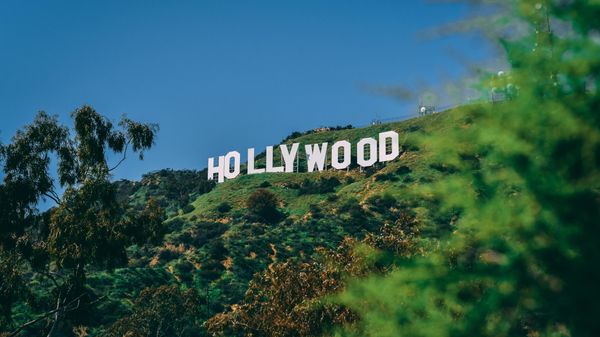
In the opening sequence of Nicolas Roeg’s Don’t Look Now, a little girl in a red raincoat drowns in a pond in the English countryside, as her parents are nestled comfortably in a nearby estate. Roeg cuts frantically between the girl tooling around the pond in her boots and her father John (Donald Sutherland) at work inside, examining a projected image of an Italian cathedral he intends to restore. The cutting works as suspense, leaving the audience utterly helpless to stop this inevitable tragedy from happening, but it has a much more sophisticated agenda than goosing our emotions. Through color and montage effects, tied to shots like a spill that bleeds over John’s slide, Roeg dramatizes the present and predicts the future all at once, signaling the heartbreak and terror to come.
Time collapses in Don’t Look Now. The past and future are folded into the present. Anyone who has seen Roeg’s work from this peak period of his career – this film was preceded by the sensual Outback adventure Walkabout and the elliptical science fiction of The Man Who Fell to Earth – will recognize his intuitive, semi-experimental editing and how much it pushed the boundaries of commercial cinema. Yet there’s something special about the way certain patterns and visual motifs keep cycling through this film, a reminder that grief can strike at any time for John and his wife Laura (Julie Christie), no matter how far they run from it.
Based on Daphne du Maurier’s short story, the film moves quickly from the girl’s death to the couple relocating in Venice, where John has accepted a commission to work on the church. Roeg doesn’t specify how much time has passed, but it hasn’t been enough. John has thrown himself into this project to distract him from his guilt and grief, but Laura marinates in it, popping pills and looking overwhelmed with sadness. That makes her vulnerable to the influence of two elderly sisters, one a blind seer who claims to have a psychic connection with the deceased girl, which changes Laura’s mood. Meanwhile, a spate of murders are bringing a particular menace to the city’s canals and catacombs.
Staging a haunting in Venice 50 years before Kenneth Branagh, Roeg and his ace cinematographer, Anthony Richmond, convert a romantic city into a gothic nightmare in winter, emptied of tourists and conspicuously overcast, with an emphasis on the rot chipping away at the façades. It’s a cliche to call a city a “character”, but Roeg certainly makes Venice a presence, hostile to these outsiders who are trying so desperately to find their footing in a new environment. There’s also a sense of the uncanny that creeps into the picture, especially for John, who is experiencing more premonitions of the kind that struck him in the moments before the drowning. The vibes in this city are decidedly not impeccable.
And yet, like a desert flower poking through concrete, Don’t Look Now also happens to include one of the sexiest love scenes in film history. During a rare break in the clouds, when Laura’s encounter with the seer gives her a temporary peace, she and John share a lusty hotel-room session that was remarkable, then and now, for its frankness, especially with actors of Sutherland and Christie’s stature. But in keeping with the film’s temporal loops, Roeg cuts between vigorous sex acts and the post-coital scene of John and Laura getting dressed for dinner. Twenty-five years later, Steven Soderbergh, a huge Roeg admirer, would modify the sequence for his own famously steamy rendezvous between George Clooney and Jennifer Lopez in Out of Sight.
The bliss is short-lived. Though John does see a diminutive figure in a red raincoat that reminds him of his daughter, his fitful extrasensory perception is hard to comprehend and may relate to his future as much his past. He attempts to throw himself into his work, but it’s unsatisfying and dangerous, and in the meantime he’s mostly detached from his wife, who seems to be chasing phantoms. The two are hung up in a kind of unsettling limbo that Roeg reinforces through recurring images that create a sense of déjà vu and a creeping psychological deterioration. The film may not be a supernatural thriller per se, but the action does seem dictated by forces that are mysterious and beyond comprehension, something much crueler than fate.
The mesmeric quality of Don’t Look Now has the effect of lulling the audience into a stupor, as if the patterns its characters are stuck in will repeat themselves forever. After all, John and Laura cannot shake the ache of losing their only child and the world seems to conspire to make sure those memories are always accessible and on-the-surface. And so it comes as an extra shock when Roeg pulls off a climactic jump-scare for the ages, when John finally catches up to the child-like figure in the red raincoat and the timelines converge in a breath-catching burst of violence.
Yet the way Roeg links this moment in Venice to the drowning in the opening sequence makes Don’t Look Now feel like a closed loop, an inescapable plague of death and loss. For as much as du Maurier’s story provides in otherworldly creepiness, the film’s insight into the nature of grief is its most lasting quality and among its most teasingly enigmatic. John and Laura are trying to process an incomprehensible loss and they carry an ache with them that asserts itself as acute pain at unexpected moments. That’s the real-life horror at the heart of this supernatural tale.







